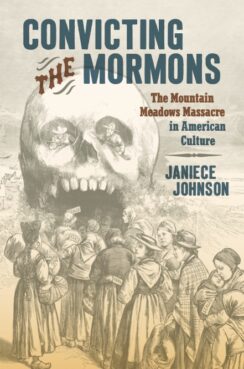
(RNS) — In September of 1857, more than 100 people on their way from Arkansas to California camped in Southern Utah in a place called Mountain Meadows to rest their horses and livestock before pushing on toward the final leg of their journey.
Apart from 17 children ages 6 and under who were spared, the entire company was murdered in cold blood by a group of mostly Mormon men, who for years attempted to blame the attack on the Paiute Tribe.
Why did this happen, and why are people still so interested in it?
Two new books aim to uncover the answers to those questions. One of the books focuses primarily on the who, how and why of the massacre itself. The other addresses the long and largely unsuccessful quest to punish the guilty. Both are written by active Latter-day Saints, and both aim to tell the raw truth about Mormon involvement in planning, leading, carrying out and covering up the attack.
The first book, “Vengeance Is Mine: The Mountain Meadows Massacre and Its Aftermath” (Oxford, May 30), co-written by historians Richard E. Turley and Barbara Jones Brown, has been years in the making. It’s a sequel to 2008’s “Massacre at Mountain Meadows,” which both authors helped to research, write and edit. Between them, Turley and Jones Brown have a combined 41 years of research and writing about Mountain Meadows.
- Richard E. Turley, co-author of “Vengeance Is Mine.” Photo courtesy of Oxford University Press.
- Barbara Jones Brown, co-author of “Vengeance Is Mine.” Photo courtesy of Oxford University Press.
Untangling the truth is difficult, because Mormons lied to cover their own or their neighbors’ involvement and because the narrative was embellished over time.
As to the embellishment, “Vengeance Is Mine” debunks several of the longstanding myths surrounding Mountain Meadows, including some promulgated by Jon Krakauer’s bestselling 2003 book “Under the Banner of Heaven,” which is the most popular treatment of it.
One of those enduring myths is that Brigham Young, then the president of the church, ordered the attack. The historical record actually shows Young issuing an order not to interfere with the emigrant train — an order that was sent before the massacre but did not arrive in time to prevent it.
On the other hand, Jones Brown said, the record also indicates that Young’s incendiary rhetoric in the months leading up to Mountain Meadows helped set the stage for “war hysteria.” At that time in 1857, the federal government was sending troops to Utah Territory, purportedly to keep the peace, but Young saw it as an act of war.
So while Young did not sanction the attack on the emigrants, he’s not off the hook. “I hope people won’t think that because we didn’t find that Brigham Young ordered the massacre, this is an apologetic book,” Jones Brown told RNS in a Zoom interview. Young’s fiery public words created conditions that made violence toward outsiders a dangerously real possibility.
Another myth is that the Mormons were attacking the Arkansas wagon train to avenge the recent murder of one of their apostles, who had been killed in Arkansas earlier that year.

Janiece Johnson, author of “Convicting the Mormons.” Courtesy of Johnson.
Not accurate, says historian Janiece Johnson, a lecturer at Brigham Young University and author of the second new Mountain Meadows book, “Convicting the Mormons: The Mountain Meadows Massacre in American Culture” (UNC Press, May 30). (Disclosure: I was Johnson’s freelance editor as she revised this project from a dissertation into a book.)
While it’s true that apostle Parley P. Pratt was murdered in Arkansas several months earlier in 1857, the location was largely a coincidence; he was fleeing through the state as he tried to outrun the first husband of one of Pratt’s plural wives. Pratt happened to have just crossed the state line into Arkansas when the first husband caught up to him.
Despite the Arkansas connection being only a coincidence, the story began very quickly that the Mountain Meadows Massacre occurred specifically because the Mormons were seeking retribution for Pratt’s death. Johnson says that connection “grew over time” in the press, as newspapers sought ever more lurid details about the Mormons’ crime.
 Johnson’s book focuses on the expanding, evolving narrative of Mountain Meadows in the late 19th century and into the 20th. As the general editor of the Mountain Meadows Legal Papers, she spent years poring over more than 3,000 pages of transcripts from the two trials of John D. Lee from the 1870s, nearly two decades after the event. (Lee was the only man ever convicted of the crime, for which he was executed by a firing squad in 1877.)
Johnson’s book focuses on the expanding, evolving narrative of Mountain Meadows in the late 19th century and into the 20th. As the general editor of the Mountain Meadows Legal Papers, she spent years poring over more than 3,000 pages of transcripts from the two trials of John D. Lee from the 1870s, nearly two decades after the event. (Lee was the only man ever convicted of the crime, for which he was executed by a firing squad in 1877.)
Johnson found it wasn’t only Lee who was on trial, but the Mormon people.
“They wanted to demonstrate that Latter-day Saints were not worthy of citizenship,” Johnson said in a separate Zoom interview. The Mountain Meadows Massacre proved a “multi-use tool” for exploring the many areas Mormons were thought to be dangerously outside the bounds of what was called “white civilization.”
“If you’re concerned about Indians and you see Mormons uniting themselves with Indians, then Mountain Meadows is your answer. If you are concerned with ideas about manhood and protecting femininity, Mountain Meadows is your ready-fit tool.” So, too, with Americans’ growing concerns about Mormon theocracy, polygamy and race.
Part of the reason, then, that people continue to be fascinated with Mountain Meadows, Johnson said, is that its narrative has been malleable, adapting to fit the needs of particular historical moments. (In America today, for example, the new concern in a society that grows less religious every year may be what Krakauer claimed: that religion will inevitably result in extremism and violence.)
All three authors point out that society’s longstanding fixation with Mountain Meadows has a racial component, since other, larger massacres in the 19th century get little public attention by comparison. In those cases, the victims were Native American.
“Mountain Meadows was a racial crime in multiple senses,” Turley said. “One was that from the very beginning, those who planned and led the massacre intended to blame it on their Paiute neighbors, some of whom were likely baptized members of their own church.
“And then this got a tremendous amount of national attention, with some calling it the crime of the century. But that overlooks a great number of massacres of native peoples, some of which have begun to get some attention and some of which have not. If you say Sand Creek or Bear River, I would guess that fewer than 1% of the United States population has any idea what you’re talking about.”
All three authors also said it has taken an emotional toll to delve into such a dark topic for a long period.
Johnson said she was “physically sick for weeks on end” at one point in her research. And Turley noted that “Mountain Meadows is a topic that sucks the life out of the writer.”
“Everybody working on the project had experienced pain to various degrees as we uncovered the full facts of the story and encountered it and stared it straight in the face,” Barbara Jones Brown said.
For her, this became very personal, because she discovered during the course of the research that she’s a descendant of William S. Hawley, one of the massacre’s culprits.
“I was stunned,” she said. On the one hand, the 50 to 60 perpetrators included many polygamists, so it’s likely they now have hundreds of thousands of descendants, including many in Utah, where she lives. So in that sense, discovering an ancestor among the murderers was not surprising. But in a deeper sense, it was shocking and painful to realize a member of her own family had helped to commit the atrocity she had spent years studying.
What has brought her peace has been forging relationships with the families of the victims. “Reaching out to descendants of victims, hearing their pain and just saying how sorry I am — that has brought me incredible peace and joy.” The way forward, she said, is to continue digging for the truth — and to resist the temptation to deny or excuse the horrific murders that Latter-day Saints committed nearly 166 years ago.
“The way to find peace is to face the truth and own it, and reach out in a spirit of sorrow,” Jones Brown said.
Related content:
Faithful Mormons won’t be happy with Hulu’s “Under the Banner of Heaven”


